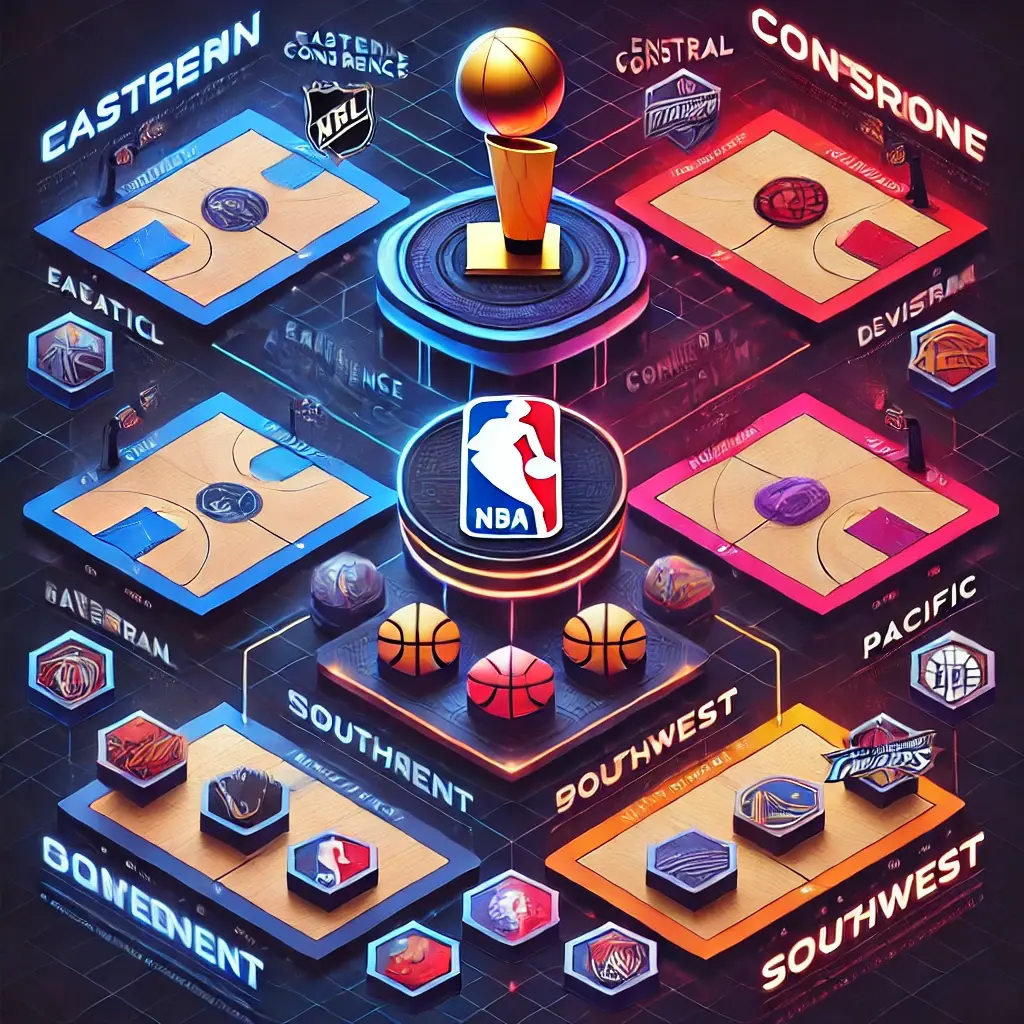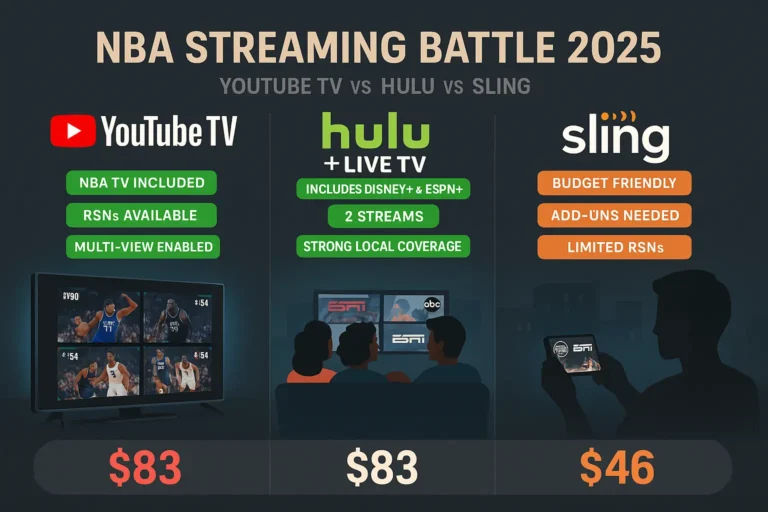NBA Divisions and Conferences
The NBA divisions and conferences play a crucial role in organizing the league, fostering competitive balance, and creating exciting matchups. From the very beginning, the structure of the NBA has been designed to divide teams into two major conferences — the Eastern and Western — with multiple divisions within each. This system not only helps with scheduling and travel logistics but also ensures that teams compete within their own regions while maintaining fairness throughout the league.
Over the years, the NBA divisions and NBA conferences have evolved. As the league expanded to accommodate more teams, realignments and new divisions were created. This evolution has been pivotal in shaping the competitive dynamics of the league, influencing everything from playoff qualification to key rivalries.
In this article, we’ll explore the historical development of the NBA’s divisional and conference structures, examining how they’ve changed over time and their current impact on the NBA standings and playoffs.
🌍 The Evolution of NBA Divisions and Conferences
The structure of the NBA conferences and divisions has undergone significant changes since the league’s inception. These changes have been driven by the need to accommodate new teams, improve competitive balance, and adapt to the league’s growing popularity. Here’s a look at how the NBA divisions and NBA conferences evolved over the years.
🟩 Early NBA Structure (1940s-1960s)
When the NBA was founded in 1946 as the Basketball Association of America (BAA), the league consisted of only 11 teams. Back then, the NBA had just two conferences: the Eastern and Western Conferences.
- Conferences and Teams:
In these early years, the teams were often grouped based on geography, but there were no official divisions. For example, teams like the Boston Celtics and New York Knicks were considered part of the Eastern Conference, while teams like the Chicago Stags and Minneapolis Lakers were placed in the Western Conference. - Key Teams:
The early structure of the NBA was dominated by teams like the Celtics and the Lakers, with the Celtics winning the majority of the league’s championships during this period.
🟦 Expansion and Realignment (1970s-1990s)
As the NBA continued to grow, the league expanded both in terms of teams and geographic reach. The 1970s and 1980s marked a significant period of change for the NBA as the league went through several rounds of expansion and realignment.
- More Teams:
By the 1970s, the NBA had expanded to include new teams, such as the Portland Trail Blazers and New Orleans Jazz (later to become the Utah Jazz). This led to the creation of divisions within the existing conferences. - Creation of Divisions:
In the early 1980s, the NBA officially created divisions within each conference to help manage scheduling and competition. The Eastern Conference became home to the Atlantic Division, Central Division, and Southeast Division, while the Western Conference had the Pacific Division, Midwest Division, and Southwest Division. - Increased Rivalries:
During this time, teams like the Boston Celtics and Los Angeles Lakers became iconic in the NBA due to their fierce rivalry, which was partly shaped by their position in the same division. This period solidified the importance of divisions in determining playoff matchups and rivalries.
🟧 Modern-Day NBA (2000s-Present)
Today, the NBA consists of 30 teams divided into two main conferences — the Eastern and Western Conferences — with each conference further divided into three divisions.
- Current Structure:
The Eastern Conference houses teams like the Boston Celtics, Miami Heat, and Chicago Bulls, while the Western Conference includes teams like the Golden State Warriors, Los Angeles Lakers, and Denver Nuggets. Each conference’s top 8 teams are seeded based on their regular-season record, and divisional standings often play a role in determining home-court advantage. - Realignment Adjustments:
In recent years, the NBA has gone through minor realignment adjustments to accommodate the increasing number of teams. The Memphis Grizzlies, for example, moved from the Eastern Conference to the Western Conference in 2004. This change reshaped both conferences, with the Western Conference becoming particularly competitive in recent years.
🏆 Impact of Divisions on Standings and Playoffs
The NBA’s divisional and conference system has a significant impact on how teams qualify for the playoffs and how playoff matchups are set. Here’s how the divisions and conferences affect standings and playoff qualification:
🟩 Conference vs. Divisional Standings
While the NBA standings are organized by conference (Eastern and Western), the divisions within each conference play an important role in determining playoff spots, home-court advantage, and seeding.
- Top 6 Teams per Conference:
The top 6 teams from each conference automatically qualify for the playoffs. These teams are seeded 1 through 6, and the playoff picture is based on their conference standings, not just their divisional rankings. - Divisional Champions:
The winner of each division automatically secures a spot in the top 4 seeds in their respective conference. This rule ensures that teams from each division are represented in the playoffs, but it can sometimes result in lower-seeded teams making the postseason if they win their division while finishing with a poor overall record. - Example:
A team that finishes 5th in the conference overall may be forced to face the 4th seed (the division winner), even though the 5th seed had a better record. This is the consequence of divisional standings playing a role in seeding.
🟦 Playoff Seeding and Home-Court Advantage
- Home-Court Advantage:
In each playoff series, the higher-seeded team gets home-court advantage for Games 1, 2, 5, and 7. The home team gets to play more games in front of their fans, which has historically been a significant advantage in the postseason.- Seeding Considerations:
A team with a strong regular-season record but a lower divisional placement can be disadvantaged if they face a divisional champion with a worse record but a better seed due to their divisional win.
- Seeding Considerations:
- Conference Finals:
The winners of the Eastern Conference and the Western Conference face off in the NBA Finals. Their standings within their conferences can affect how home-court advantage plays out in this series. The higher-seeded team in the conference finals gets home-court advantage based on their regular-season performance.
🟧 Divisional Rivalries and Their Influence
Divisional rivalries have become a central part of the NBA’s competitive landscape. The structure encourages competition within divisions, which often leads to fierce rivalries. These rivalries add intensity to the playoffs and create high-stakes games, especially when teams are evenly matched.
- Notable Divisional Rivalries:
- Celtics vs. Knicks (Atlantic Division rivalry)
- Lakers vs. Clippers (Pacific Division rivalry)
- Bulls vs. Pistons (Central Division rivalry)
- These rivalries shape regular-season matchups and can influence how teams approach the playoffs.
🔄 Changes Over Time: NBA Realignment and Expansion
The NBA has undergone several realignments and expansions since its inception, as new teams were added and divisions needed to be adjusted to maintain competitive balance. These changes have shaped the structure of the league, influencing both the conference and divisional makeup and the overall playoff picture. Let’s explore how these realignments and expansions have affected the league.
🟩 The Effects of Realignment on the League
As the NBA grew, realignment was necessary to accommodate new teams and ensure that the divisions remained competitive. Key realignments included:
- 1976 ABA-NBA Merger:
The ABA-NBA merger in 1976 brought in four new teams: the Denver Nuggets, Indiana Pacers, New Jersey Nets (now the Brooklyn Nets), and the San Antonio Spurs. These teams were integrated into the NBA’s structure, and several divisional changes were made to balance the league. - The 1980s Realignment:
In the early 1980s, the NBA went through several realignments, adding divisions within both the Eastern and Western Conferences. This was part of an effort to better organize teams based on geographic proximity, which made scheduling and travel easier. - The 2004 Realignment:
In 2004, the Memphis Grizzlies were moved from the Eastern Conference to the Western Conference due to league expansion. This was a major realignment that shifted the balance of competition between the conferences.
🟦 The Introduction of New Teams
- Expansion Teams:
The NBA’s expansion into new markets also brought changes to the divisions and conferences:- Toronto Raptors (1995) and Vancouver Grizzlies (now Memphis Grizzlies) were added to the league.
- These teams were placed in the Western Conference initially, with the Grizzlies moving to the East after the 2001 season.
- Recent Additions:
The most recent addition, the Charlotte Hornets, was re-established in 2004, and their placement in the Southeast Division reflected the continued need for realignment as the league expanded.
🟧 Impact on the Competitive Landscape
Realignment has had a lasting impact on the balance of power in the league. The Western Conference has historically been the more competitive conference, and realignment efforts have aimed to keep the conferences relatively balanced, with teams like the San Antonio Spurs and Golden State Warriors dominating their respective eras in the West.
- Division Strength Changes:
Divisions that were once seen as stronger, such as the Pacific Division (with teams like the Lakers, Warriors, and Suns), have had their own cycles of dominance, while other divisions like the Southeast Division have struggled to produce consistent championship contenders. - Future Expansion:
If the NBA continues to expand, there will likely be more realignments. The current structure has become quite stable, but with new teams possibly coming from international markets or new U.S. cities, future changes are inevitable.
🧠 Fun Facts About NBA Divisions and Conferences
The NBA divisions and conferences have been integral to the league’s history and identity. Over the years, some interesting stories and fun facts have emerged about the structure of the league. Here are a few notable tidbits:
🏆 The Most Competitive Divisions in NBA History
Some divisions in the NBA have been historically more competitive than others. A few standout examples include:
- The Pacific Division (West)
Home to legendary teams like the Los Angeles Lakers, Golden State Warriors, and Phoenix Suns, the Pacific Division has consistently been one of the most competitive, with multiple championship teams coming out of this division over the years. - The Central Division (East)
During the 1990s, the Central Division was a powerhouse, featuring teams like the Chicago Bulls (with six championships) and the Indiana Pacers, making this division one of the most influential in NBA history.
🏅 Most Divisional Championships by Team
Some teams have dominated their divisions, collecting multiple divisional titles over the years. Notable examples include:
- Boston Celtics – With 17 championships and numerous divisional titles in the Atlantic Division, the Celtics remain a storied franchise.
- Los Angeles Lakers – Another team with a rich history of divisional dominance, particularly in the Pacific Division, the Lakers have secured numerous Western Conference titles.
- San Antonio Spurs – Known for their consistency, the Spurs have claimed 19 divisional championships throughout their history, dominating the Southwest Division.
🌍 The Role of Divisions in the NBA Draft
Divisions also have an impact on how the NBA manages the draft process. Teams that finish at the bottom of their divisional standings have higher chances of securing a higher pick in the NBA Draft. This is designed to help weaker teams build their rosters and improve their standing in future seasons.
- Lottery System: The NBA Lottery System helps prevent teams from tanking to secure the best draft prospects, but division standings still play a key role in where teams land in the draft order.
🔁 Teams That Have Changed Conferences or Divisions
Over the years, several teams have switched conferences or divisions as the league expanded and realigned:
- Memphis Grizzlies: The Grizzlies were originally part of the Western Conference but were moved to the Eastern Conference for the 2004-05 season, before they returned to the West in 2004 following league expansion.
- New Orleans Pelicans: Originally part of the Western Conference in the Southwest Division, the Pelicans were reassigned to the Western Conference in 2005, reflecting a shift in competition dynamics.
🏁 The NBA’s Conference and Divisional Legacy
The NBA’s divisional and conference system has been central to shaping the league’s identity. Divisions have helped build fierce rivalries, define playoff matchups, and provide exciting regular-season contests. They also add a layer of strategy to the NBA playoffs and regular-season games, making each division battle worth watching.
❓ Frequently Asked Questions (FAQ)
❓ Why does the NBA have divisions and conferences?
Divisions and conferences were created to help organize the league, reduce travel time, and promote regional rivalries. The NBA conferences (Eastern and Western) also help balance competition, while divisions within each conference ensure teams face their closest geographical rivals more often during the regular season.
❓ How are NBA playoffs affected by divisions?
Divisions play an important role in NBA playoff seeding. While the top 8 teams from each conference qualify for the playoffs, the divisional champions are guaranteed to be placed in the top 4 seeds, regardless of their overall record. This sometimes leads to lower-seeded teams from a division advancing to the playoffs, even if their win-loss record is worse than non-divisional teams.
❓ Has the NBA ever changed its divisional and conference alignment?
Yes! The NBA has undergone several realignments throughout its history. Notable realignments include the 1976 ABA-NBA merger, which introduced new teams, and the 2004 relocation of the Memphis Grizzlies from the Eastern Conference to the Western Conference. These changes have been essential in maintaining competitive balance as the league expanded.
❓ Can a team win the NBA championship without winning their division?
Yes! While divisional champions automatically secure a top 4 seed in their conference, a team can still win the NBA Championship without winning their division. Playoff seeding is based on regular-season records, so a team with a better overall record but a lower divisional ranking can still advance and win the championship.
❓ What are some of the most notable NBA divisional rivalries?
Some of the most iconic divisional rivalries in NBA history include:
- Lakers vs. Celtics (Pacific Division vs. Atlantic Division)
- Bulls vs. Pistons (Central Division)
- Warriors vs. Clippers (Pacific Division)
- Knicks vs. Nets (Atlantic Division)
These matchups often add extra intensity to regular-season games and have played a huge role in shaping the playoff picture.
🏁 Conclusion
The NBA divisions and conferences have been fundamental in shaping the league’s competitive structure and history. From the early days of the NBA to its current 30-team format, the evolution of divisions and conferences has helped promote regional rivalries, provide balance across the league, and create exciting playoff matchups.
Understanding how the NBA divisions work, and how they impact playoff seeding and team dynamics, gives fans a deeper appreciation for the strategy behind the game. As the NBA continues to grow and evolve, the divisional and conference structure will undoubtedly continue to play a key role in shaping the future of the league.
📌 Stay tuned to see how divisional rivalries, realignments, and emerging teams will continue to influence the NBA landscape!






